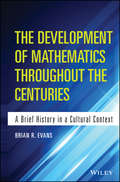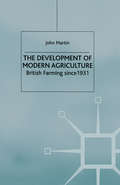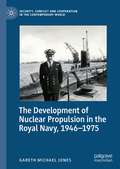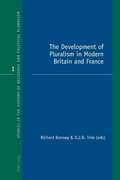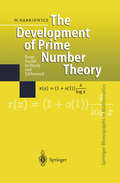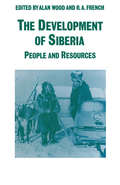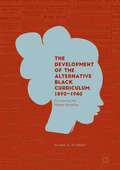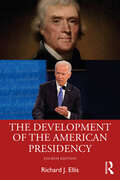- Table View
- List View
The Development of Mathematics Throughout the Centuries: A Brief History in a Cultural Context
by Brian EvansThroughout the book, readers take a journey throughout time and observe how people around the world have understood these patterns of quantity, structure, and dimension around them. The Development of Mathematics Throughout the Centuries: A Brief History in a Cultural Contex provides a brief overview of the history of mathematics in a very straightforward and understandable manner and also addresses major findings that influenced the development of mathematics as a coherent discipline. This book: Highlights the contributions made by various world cultures including African, Egyptian, Babylonian, Chinese, Indian, Islamic, and pre-Columbian American mathematics Features an approach that is not too rigorous and is ideal for a one-semester course of the history of mathematics. Includes a Resources and Recommended Reading section for further exploration and has been extensively classroom-tested
The Development of Mathematics Throughout the Centuries: A Brief History in a Cultural Context
by Brian EvansThroughout the book, readers take a journey throughout time and observe how people around the world have understood these patterns of quantity, structure, and dimension around them. The Development of Mathematics Throughout the Centuries: A Brief History in a Cultural Contex provides a brief overview of the history of mathematics in a very straightforward and understandable manner and also addresses major findings that influenced the development of mathematics as a coherent discipline. This book: Highlights the contributions made by various world cultures including African, Egyptian, Babylonian, Chinese, Indian, Islamic, and pre-Columbian American mathematics Features an approach that is not too rigorous and is ideal for a one-semester course of the history of mathematics. Includes a Resources and Recommended Reading section for further exploration and has been extensively classroom-tested
The Development of Mexico’s Tourism Industry: Pyramids by Day, Martinis by Night (New Directions in Latino American Cultures)
by D. BergerBerger argues that tourism was forged by Mexico's government in 1928 as the cornerstone of state-led modernization programmes. Berger presents tourism as the leading and influential facet of the post-revolutionary modernization programme. She also examines how tourism fostered nationalism and unity, and emerged as a new form of foreign diplomacy.
The Development of Mine Warfare: A Most Murderous and Barbarous Conduct (War, Technology, and History)
by Norman E. YoungbloodIn 1997, the International Campaign to Ban Landmines (ICBL) coordinated the Convention on the Prohibition of the Use, Stockpiling, Production, and Transfer of Anti-Personnel Mines and on their Destruction. As of mid-2005, 145 states had signed the agreement. The ICBL's efforts were in large part a response to the careless use of landmines in the previous fifty years. The history of mine use in warfare, however, goes back much further than the World Wars of the 20th century and includes both land and sea use. This first comprehensive study traces the technical, tactical, and ethical developments of mine warfare, from ancient times to the present.Beginning with mine warfare's roots in ancient Assyria and China, Youngblood takes the reader through the centuries of debate about how these hidden weapons should be used. A look at 19th-century developments explores the intertwined development of land and sea mines and the inventors behind them, including Robert Fulton, Samuel Colt, and Immanuel Nobel, father of Alfred Nobel. Subsequent chapters examine the use of mines in the American Civil War, the Russo-Japanese War, both World Wars, and the battlefields of the Cold War, and chart key battles and technical innovations, such as the development of air-delivered munitions. Finally, the author addresses the ethical concerns raised by the careless mining, namely the impact on civilians and the difficulties of de-mining, and the treaties that regulate landmine use.
The Development of Modern Agriculture: British Farming since 1931
by J. MartinThis highly readable and up-to-date history provides an informative critique of the causes and consequences of the modern agricultural revolution, since the agricultural depression of the inter-war period. This includes evaluating the impact of the Second World War, the post-war scientific and technological revolutions and the metamorphosis in the role of the state. It also examines the impact of the Common Agricultural Policy and the more recent attempts to rationalize production. The book provides the essential background for an objective appreciation of modern agricultural development.
The Development of Modern Business
by Simon Ville Gordon BoyceThis text blends economic theory with empirical evidence to chart business development over the last two centuries in the UK, the United States, Japan and Australia. It addresses enduring concerns for entrepreneurs and managers and demonstrates the value of an historical perspective from which to judge present day issues. Each chapter considers an issue of current significance, introduces theories to illuminate the topic, and discusses historical evidence and debates. Also included are relevant case studies and original documents. Discussion questions, statistical tables, and further reading are appended to each chapter.
The Development of Nuclear Propulsion in the Royal Navy, 1946-1975 (Security, Conflict and Cooperation in the Contemporary World)
by Gareth Michael JonesThis book examines the development of nuclear propulsion in the Royal Navy from the first proposal in 1946 to the start-up of the last core improvement for the first submarine reactor power plant PWR 1 in December 1974. Drawing from unreleased records and archives, the book answers questions around three main themes. Political: what problems were encountered in transferring nuclear knowledge from the USA to the UK in the post-war period, and how much support was there for the development of nuclear propulsion? Military: why was there a requirement to develop nuclear propulsion, and in particular, why submarines? Technical: were the problems associated with nuclear energy fully appreciated, and did the UK have the technical and engineering capability to develop nuclear propulsion? Aside from the political considerations and military motives for developing nuclear propulsion in the Royal Navy, the author focuses on the technical problems that had to be overcome by all participants in the Royal Navy’s development of nuclear propulsion, adding significantly to naval historiography. Providing a critical analysis of the political, technological, operational and industrial issues of introducing nuclear propulsion into the Royal Navy, the author situates his research in the context of the evolving Cold War, changing Anglo-American relations, the end of Empire and the relative decline of British power.
The Development of Old English (A Linguistic History of English #2)
by Don Ringe Ann TaylorThis book, the second volume in A Linguistic History of English, describes the development of Old English from Proto-Germanic. Like Volume I, it is an internal history of the structure of English that combines traditional historical linguistics, modern syntactic theory, the study of languages in contact, and the variationist approach to language change. The first part of the book considers the development of Northwest and West Germanic, and the northern dialects of the latter, with particular reference to phonological and morphological phenomena. Later chapters present a detailed account of changes in the Old English sound system, inflectional system, and syntax. The book aims to make the findings of traditional historical linguistics accessible to scholars and students in other subdisciplines, and also to adopt approaches from contemporary theoretical linguistics in such a way that they are accessible to a wide range of historical linguists.
The Development Of Pluralism In Modern Britain And France (PDF)
by Richard J. Bonney David J. B. TrimEurope is increasingly multi-ethnic and multi-faith, as well as multi-cultural. Western democracies now comprise a plurality of fundamental opinions and inherited cultures; it is not clear how (or if!) they can be related to each other without involving either oppression or anarchy. This debate requires historical understanding and a contemporary grasp of the points at issue amongst different cultures. By virtue of their proximity and frequent historical interaction, Britain and France lend themselves to comparative study. The studies in this volume collectively demonstrate that the affairs of religious minorities in these two countries were not only of concern to themselves and their national established churches. Rather, over a long-term period, they had a sustained impact on many other issues. All chapters illustrate the problematic shift from a persecutory to a pluralistic mentality.
The Development of Prime Number Theory: From Euclid to Hardy and Littlewood (Springer Monographs in Mathematics)
by Wladyslaw Narkiewicz1. People were already interested in prime numbers in ancient times, and the first result concerning the distribution of primes appears in Euclid's Elemen ta, where we find a proof of their infinitude, now regarded as canonical. One feels that Euclid's argument has its place in The Book, often quoted by the late Paul ErdOs, where the ultimate forms of mathematical arguments are preserved. Proofs of most other results on prime number distribution seem to be still far away from their optimal form and the aim of this book is to present the development of methods with which such problems were attacked in the course of time. This is not a historical book since we refrain from giving biographical details of the people who have played a role in this development and we do not discuss the questions concerning why each particular person became in terested in primes, because, usually, exact answers to them are impossible to obtain. Our idea is to present the development of the theory of the distribu tion of prime numbers in the period starting in antiquity and concluding at the end of the first decade of the 20th century. We shall also present some later developments, mostly in short comments, although the reader will find certain exceptions to that rule. The period of the last 80 years was full of new ideas (we mention only the applications of trigonometrical sums or the advent of various sieve methods) and certainly demands a separate book.
The Development of Professional Management: Training, Consultancy, and Management Theory in Industrial History (Routledge Focus on Industrial History)
by John F. Wilson Ian Jones Steven TomsThis shortform book presents key peer-reviewed research selected by expert series editors and contextualised by new analysis from each author on the development of professional management. With contributions on consultancy and training consultants, Taylorism and its appeal to socialists, the social position of managers, and the growth of the managerial class. Of interest to business and economic historians, this shortform book also provides analysis and illustrative case-studies that will be valuable reading across the social sciences.
The Development of Professional Management: Training, Consultancy, and Management Theory in Industrial History (Routledge Focus on Industrial History)
by John F. Wilson Ian Jones Steven TomsThis shortform book presents key peer-reviewed research selected by expert series editors and contextualised by new analysis from each author on the development of professional management. With contributions on consultancy and training consultants, Taylorism and its appeal to socialists, the social position of managers, and the growth of the managerial class. Of interest to business and economic historians, this shortform book also provides analysis and illustrative case-studies that will be valuable reading across the social sciences.
The Development of Quine's Philosophy (Boston Studies in the Philosophy and History of Science #291)
by Murray MurpheyThis book covers W. V. Quine's philosophic career from his early radical empiricism and behaviorism through his development of a series of skeptical doctrines regarding meaning, reference, and science. It shows what problems he tried to solve and what his solutions were. Result has been a series of highly controversial claims that have won him international fame. His work is still a center of controversy and has lead to an enormous literature of commentary.
The Development of Radar Equipments for the Royal Navy, 1935–45
by F. A. KingsleyThis book presents authoritative accounts of the evolution, development and application of Royal Naval radar from its inception in 1935 until the end of World War 2. The accounts are based on the individual authors' contemporary experiences, extensive archival research and discussions with surviving wartime colleagues. An overview is presented of the pioneering work at HM Signal School (later the Admiralty Signal Establishment), followed by descriptions of the main programmes of radar development, associated research, and the problems of installation of the equipment in ships, as well as its operation and maintenance at sea. Tabulations of the characteristics and installations of all wartime Royal Naval radars are provided in the Appendices.
The Development of Railway Technology in East Asia in Comparative Perspective (Studies in Economic History)
by Minoru SawaiThis is the first book to examine the process of railway development in Japan, Korea, Taiwan, and China from historical and comparative perspectives. Moreover, it discusses and compares the East Asian experiences of railway development with cases in Germany, which was a mainstay of railway development in Europe. After the opening of Japan in the mid-nineteenth century, the country achieved import substitution of locomotives in half a century. This book explores the social capability of Meiji Japan to overtake the advanced countries in railway technology. Parallel with the expansion of the Japanese empire, a large team of engineers constructed and operated the colonial government railways of Taiwan and Korea and the South Manchuria Railway. The book clearly outlines the education and training of these engineers. The management capabilities of the colonial railways and South Manchuria Railway were transferred to the postwar period, and such expertise supported the economic development of each country and region. These dramatic East Asian experiences of railway development are compared with European cases, mainly German railways.
The Development of Scientific Marketing in the Twentieth Century: Research for Sales in the Pharmaceutical Industry (Studies for the Society for the Social History of Medicine)
by Jean-Paul GaudilliereThe global pharmaceutical industry is currently estimated to be worth $1 trillion. Contributors chart the rise of scientific marketing within the industry from 1920-1980. This is the first comprehensive study into pharmaceutical marketing, demonstrating that many new techniques were actually developed in Europe before being exported to America.
The Development of Scientific Marketing in the Twentieth Century: Research for Sales in the Pharmaceutical Industry (Studies for the Society for the Social History of Medicine #22)
by Jean-Paul GaudilliereThe global pharmaceutical industry is currently estimated to be worth $1 trillion. Contributors chart the rise of scientific marketing within the industry from 1920-1980. This is the first comprehensive study into pharmaceutical marketing, demonstrating that many new techniques were actually developed in Europe before being exported to America.
The Development of Siberia: People and Resources (pdf)
by Alan Wood Christian R. Thauer Helen Routledge R A FrenchThe Development of the Alternative Black Curriculum, 1890–1940: Countering The Master Narrative
by Alana D. MurrayThis book examines black intellectual thought during from 1890-1940, and its relationship to the development of the alternative black curriculum in social studies. Inquiry into the alternative black curriculum is a multi-disciplinary project; it requires an intersectional approach that draws on social studies research, educational history and black history. Exploring the gendered construction of the alternative black curriculum, Murray considers the impact of Carter G. Woodson and W.E.B. DuBois in creating the alternative black curriculum in social studies, and its subsequent relationship to the work of black women in the field and how black women developed the alternative black curriculum in private and public settings.
The Development of the Alternative Black Curriculum, 1890–1940: Countering The Master Narrative (PDF)
by Alana D. MurrayThis book examines black intellectual thought during from 1890-1940, and its relationship to the development of the alternative black curriculum in social studies. Inquiry into the alternative black curriculum is a multi-disciplinary project; it requires an intersectional approach that draws on social studies research, educational history and black history. Exploring the gendered construction of the alternative black curriculum, Murray considers the impact of Carter G. Woodson and W.E.B. DuBois in creating the alternative black curriculum in social studies, and its subsequent relationship to the work of black women in the field and how black women developed the alternative black curriculum in private and public settings.
The Development of the American Presidency
by Richard EllisA full understanding of the institution of the American presidency requires us to examine how it developed from the founding to the present. This developmental lens, analyzing how historical turns have shaped the modern institution, allows for a richer, more nuanced understanding. The Development of the American Presidency pays great attention to that historical weight but is organized by the topics and concepts relevant to political science, with the constitutional origins and political development of the presidency its central focus. Through comprehensive and in-depth coverage, Richard J. Ellis looks at how the presidency has evolved in relation to the public, to Congress, to the executive branch, and to the law, showing at every step how different aspects of the presidency have followed distinct trajectories of change. Each chapter promotes active learning, beginning with a narrative account of some illustrative puzzle that brings to life a central concept. A wealth of photos, figures, and tables allow for the visual presentations of concepts.New to the Fourth Edition Explicit and expanded attention to the role of norms in shaping and constraining presidential power, with special focus on Trump’s norm-breaking and Biden’s efforts to shore up norms; Enhanced focus on the prospects for institutional reform, including in the electoral college, presidential relations with Congress, war powers, and the selection of Supreme Court justices; A full reckoning with the Trump presidency and its significance for the future of American democracy, presidential rhetoric, the unilateral executive, and the administrative state; Coverage of the first year of Biden’s presidency, including presidential rhetoric, relations with Congress and the bureaucracy, use of the war powers, and unilateral directives; Comprehensive updating of debates about the removal power, including the Supreme Court cases of Seila Law v. CFPB and Collins v. Yellen; In-depth exploration of the impact of partisan polarization on the legislative presidency and effective governance; Analysis of the 2020 election and its aftermath; Expanded discussion of impeachment to incorporate Trump’s two impeachments; Examination of presidential emergency powers, with special attention to Trump’s border wall declaration; Review of Biden’s and Trump’s impact on the judiciary; Assessment of Biden’s and Trump’s place in political time.
The Development of the American Presidency
by Richard EllisA full understanding of the institution of the American presidency requires us to examine how it developed from the founding to the present. This developmental lens, analyzing how historical turns have shaped the modern institution, allows for a richer, more nuanced understanding. The Development of the American Presidency pays great attention to that historical weight but is organized by the topics and concepts relevant to political science, with the constitutional origins and political development of the presidency its central focus. Through comprehensive and in-depth coverage, Richard J. Ellis looks at how the presidency has evolved in relation to the public, to Congress, to the executive branch, and to the law, showing at every step how different aspects of the presidency have followed distinct trajectories of change. Each chapter promotes active learning, beginning with a narrative account of some illustrative puzzle that brings to life a central concept. A wealth of photos, figures, and tables allow for the visual presentations of concepts.New to the Fourth Edition Explicit and expanded attention to the role of norms in shaping and constraining presidential power, with special focus on Trump’s norm-breaking and Biden’s efforts to shore up norms; Enhanced focus on the prospects for institutional reform, including in the electoral college, presidential relations with Congress, war powers, and the selection of Supreme Court justices; A full reckoning with the Trump presidency and its significance for the future of American democracy, presidential rhetoric, the unilateral executive, and the administrative state; Coverage of the first year of Biden’s presidency, including presidential rhetoric, relations with Congress and the bureaucracy, use of the war powers, and unilateral directives; Comprehensive updating of debates about the removal power, including the Supreme Court cases of Seila Law v. CFPB and Collins v. Yellen; In-depth exploration of the impact of partisan polarization on the legislative presidency and effective governance; Analysis of the 2020 election and its aftermath; Expanded discussion of impeachment to incorporate Trump’s two impeachments; Examination of presidential emergency powers, with special attention to Trump’s border wall declaration; Review of Biden’s and Trump’s impact on the judiciary; Assessment of Biden’s and Trump’s place in political time.
The Development of the American Presidency: The Rhetorical Presidency In Historical Perspective (Political Development Of The American Nation Ser.)
by Richard J. EllisA full understanding of the institution of the American presidency requires us to examine how it developed from the founding to the present. This developmental lens, analyzing how historical turns have shaped the modern institution, allows for a richer, more nuanced understanding beyond the current newspaper headlines. The Development of the American Presidency pays great attention to that historical weight but is organized by the topics and concepts relevant to political science, with the constitutional origins and political development of the presidency its central focus. Through comprehensive and in-depth coverage, this text looks at how the presidency has evolved in relation to the public, to Congress, to the Executive branch, and to the law, showing at every step how different aspects of the presidency have followed distinct trajectories of change. All the while, Ellis illustrates the institutional relationships and tensions through stories about particular individuals and specific political conflicts. Ellis's own classroom pedagogy of promoting active learning and critical thinking is well reflected in these pages. Each chapter begins with a narrative account of some illustrative puzzle that brings to life a central concept. A wealth of photos, figures, and tables allow for the visual presentations of concepts. A companion website not only acts as a further resources base—directing students to primary documents, newspapers, and data sources—but also presents interactive timelines and practice quizzes to help students master the book's lessons. The second edition a new chapter on unilateral powers that brings greater attention to domestic policymaking.
The Development of the American Presidency
by Richard J. EllisA full understanding of the institution of the American presidency requires us to examine how it developed from the founding to the present. This developmental lens, analyzing how historical turns have shaped the modern institution, allows for a richer, more nuanced understanding beyond the current newspaper headlines. The Development of the American Presidency pays great attention to that historical weight but is organized by the topics and concepts relevant to political science, with the constitutional origins and political development of the presidency its central focus. Through comprehensive and in-depth coverage, this text looks at how the presidency has evolved in relation to the public, to Congress, to the Executive branch, and to the law, showing at every step how different aspects of the presidency have followed distinct trajectories of change. All the while, Ellis illustrates the institutional relationships and tensions through stories about particular individuals and specific political conflicts. Ellis's own classroom pedagogy of promoting active learning and critical thinking is well reflected in these pages. Each chapter begins with a narrative account of some illustrative puzzle that brings to life a central concept. A wealth of photos, figures, and tables allow for the visual presentations of concepts. A companion website not only acts as a further resources base—directing students to primary documents, newspapers, and data sources—but also presents interactive timelines and practice quizzes to help students master the book's lessons. The second edition a new chapter on unilateral powers that brings greater attention to domestic policymaking.
The Development of the Art Market in England: Money as Muse, 1730–1900 (Financial History)
by Thomas M Bayer John R. PageThis book gives a comprehensive account of the history and underlying economics of the modern art market in eighteenth- and nineteenth-century Britain.
